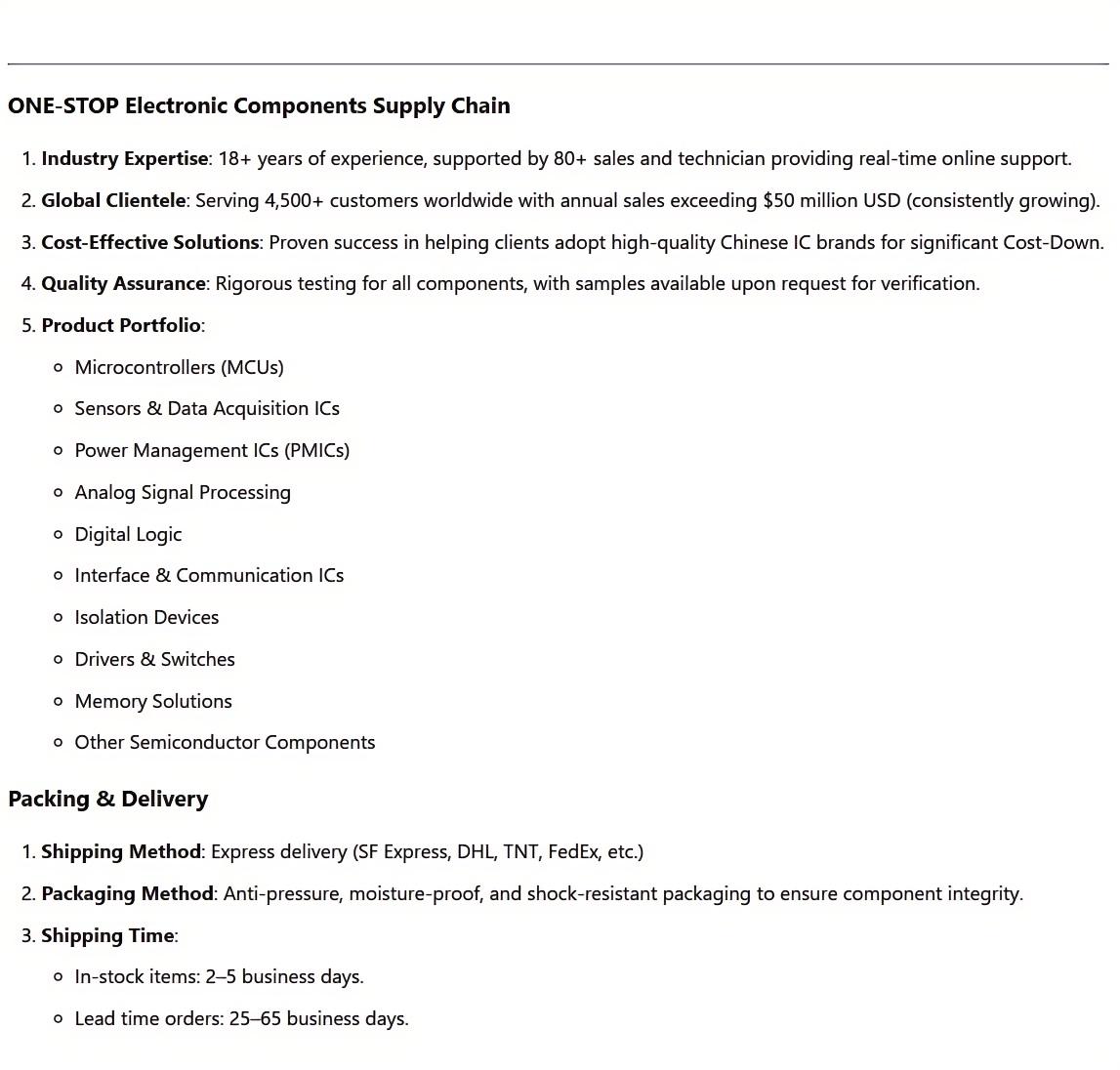GD25Q256EBIRY is a Replacement parts of
S25FL256SDSMFIG13
/S25FL256SDSMFA000
/S25FL256SDSMFA003
/MT25QL256ABA8E12-1SAT
S25FL256LAGBHI020
Mfr.Part No. :
GD25Q256EBIRYManufacturer :
GigaDeviceDescription :
Uniform Sector Dual and Quad Serial NOR FlashPackaging :
reelPackage :
TFBGA-24(6x8)Stock :
in stockPrice :
$3.1-$4.5
GD25Q256EBIRY
| Price: | $3.1-$4.5 | $5.0-$6.6 |
|
Replace parts:
Replacement parts:
Alternative parts:
Pin to pin parts:
|
GD25Q256EBIRY |
S25FL256SDSMFIG13
S25FL256SDSMFA000
S25FL256SDSMFA003
MT25QL256ABA8E12-1SAT
S25FL256LAGBHI020
|
The GD25Q256EBIRY from GigaDevice is a 256Mb NOR Flash memory chip that offers advanced features such as Quad SPI interface, high data transfer rates, and low power consumption. In this professional comparison, we will highlight the key advantages of the GD25Q256EBIRY against its competitors, including the S25FL256SDSMFIG13, S25FL256SDSMFA000, S25FL256SDSMFA003, MT25QL256ABA8E12-1SAT, and S25FL256LAGBHI020.
The GD25Q256EBIRY utilizes a Quad SPI interface, which supports a maximum clock speed of 104 MHz. This allows for faster data transfer rates, ideal for applications requiring high-speed memory access.
On the other hand, the S25FL256SDSMFIG13 from Cypress operates with a Dual SPI interface, providing a maximum clock speed of 66 MHz. This results in slower data throughput compared to the GD25Q256EBIRY. The GD25Q256EBIRY's Quad SPI interface allows for significantly higher transfer speeds, making it more suitable for high-performance systems that demand faster data access.
The GD25Q256EBIRY is designed to be power-efficient, with a standby current of 5 µA and an active read current of 12 mA. This makes it an excellent choice for battery-operated devices and IoT applications, where low power consumption is critical.
In comparison, the S25FL256SDSMFA000 offers a standby current of 6 µA and an active read current of 15 mA. While its power consumption is relatively low, the GD25Q256EBIRY offers a slightly lower standby current, providing better energy efficiency for applications that require longer battery life.
The GD25Q256EBIRY offers a high level of reliability with an endurance of 100,000 program/erase cycles and a data retention period of 20 years. These features ensure that the chip is capable of enduring frequent write operations and providing long-term data integrity.
In contrast, the S25FL256SDSMFA003 offers a lower endurance of 50,000 program/erase cycles, which may limit its lifespan in applications with higher write frequency. The GD25Q256EBIRY's higher endurance makes it better suited for write-intensive applications where longevity is a key factor.
The GD25Q256EBIRY operates within an extended temperature range of -40°C to +105°C, which allows it to perform reliably in a variety of demanding environments, including automotive, industrial, and outdoor applications.
In contrast, the MT25QL256ABA8E12-1SAT from Micron offers a narrower temperature range of -40°C to +85°C. This limitation may make it less suitable for use in applications where extreme temperatures are expected. The GD25Q256EBIRY's wider temperature range offers greater flexibility in a variety of harsh operating conditions.
The GD25Q256EBIRY features advanced hardware-based security options, including sector protection and write protection, ensuring that the data stored on the chip is safeguarded against accidental writes or unauthorized access.
In comparison, the S25FL256LAGBHI020 provides software-based protection, but lacks the hardware-level security features that the GD25Q256EBIRY offers. For applications that require higher levels of data security and protection against unauthorized access, the GD25Q256EBIRY offers enhanced security features, making it a superior choice for sensitive applications.
The GD25Q256EBIRY offers an excellent cost-to-performance ratio, delivering high-speed performance, low power consumption, and reliable operation at a competitive price point. This makes it an ideal solution for high-volume consumer electronics and cost-sensitive applications.
The S25FL256SDSMFIG13 also provides solid performance, but its Dual SPI interface and slightly higher power consumption mean that it may not offer the same level of efficiency or data throughput as the GD25Q256EBIRY at a comparable price. The GD25Q256EBIRY offers better value in terms of speed and power efficiency, making it a more cost-effective choice for many applications.
The GD25Q256EBIRY offers the following key advantages over its competitors:
Faster Performance: The GD25Q256EBIRY supports a Quad SPI interface with a 104 MHz clock speed, delivering significantly higher data throughput compared to the S25FL256SDSMFIG13 (66 MHz).
Lower Power Consumption: With a standby current of 5 µA and an active read current of 12 mA, the GD25Q256EBIRY provides superior power efficiency compared to competitors like the S25FL256SDSMFA000 (standby current: 6 µA).
Higher Endurance: Offering 100,000 program/erase cycles, the GD25Q256EBIRY provides double the endurance of the S25FL256SDSMFA003 (50,000 cycles), making it better suited for write-intensive applications.
Wider Temperature Range: The GD25Q256EBIRY's extended temperature range of -40°C to +105°C offers greater flexibility compared to the MT25QL256ABA8E12-1SAT (temperature range: -40°C to +85°C).
Enhanced Security: The GD25Q256EBIRY includes hardware-based protection features that enhance data security, whereas competitors like the S25FL256LAGBHI020 rely on software-based protection.
Cost-Effective Solution: The GD25Q256EBIRY provides high performance at a competitive price, making it an excellent value for high-volume applications.
The GD25Q256EBIRY outperforms its competitors—S25FL256SDSMFIG13, S25FL256SDSMFA000, S25FL256SDSMFA003, MT25QL256ABA8E12-1SAT, and S25FL256LAGBHI020—in several key areas, including speed, power efficiency, endurance, security, and cost-effectiveness. With its Quad SPI interface, lower power consumption, higher endurance, and wider temperature range, the GD25Q256EBIRY is the ideal choice for high-performance applications that demand reliable data storage, especially in automotive, industrial, and IoT sectors.

Hot Tags :